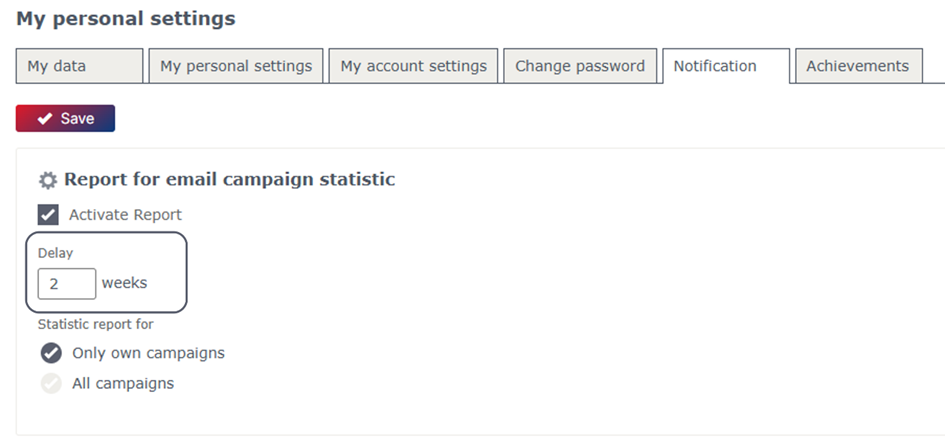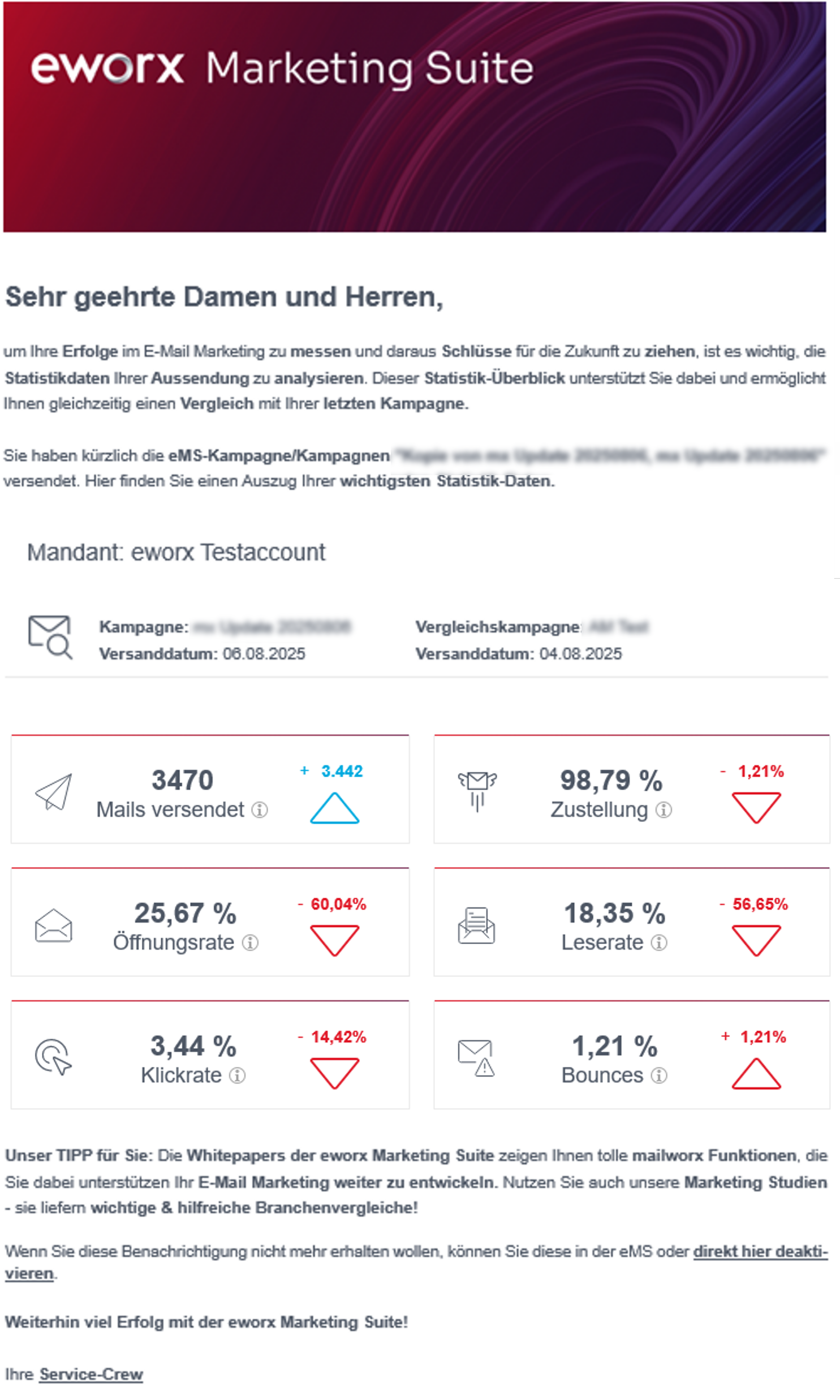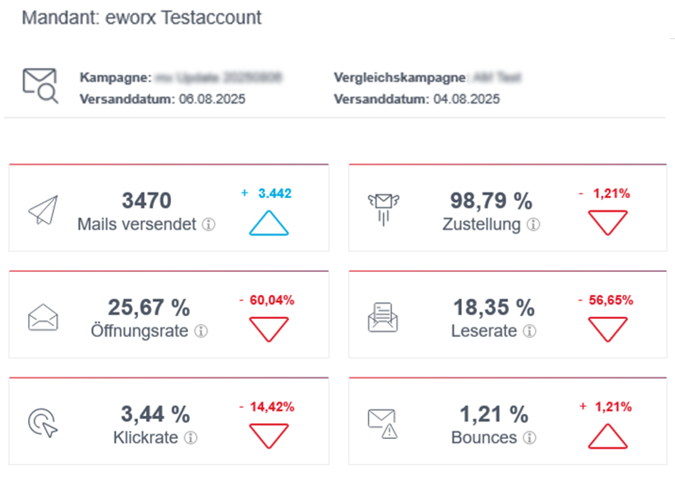[EN] Statistics Report
Subscribe to individual newsletter statistics report
Would you like to receive regular updates on your campaign statistics without having to log into the eworx Marketing Suite all the time? Then activate your individual statistics report now, which will keep you up to date on your statistics automatically and regularly via email.
How can I subscribe to a customised statistics report?
The final report, which will be sent to your personal email address, contains not only the key figures for the current campaign, but also the development of a previous campaign of the same newsletter type. We will show you how easy it is to activate this feature in the eworx Marketing Suite at any time and decide for yourself what you want to receive and how often:
In your user area, go to “My personal settings” in the “Notifications” tab to access the settings options for your statistics report.

How can I change notification settings?
Activate the “Activate Report” option in the Notification section to access detailed settings for your statistics report.
Under “Delay”, you can specify how often you want to receive your statistics reports. Simply enter the desired time interval and your statistics report will be sent to you at the specified time.
You can also decide whether you want to receive the statistics report only for your own campaigns or for all campaigns that were sent in the same account via the eworx Marketing Suite.

How does notification work with multiple accounts?
If you work with multiple accounts, you must activate notification for the statistics report in each account with the same settings. This ensures that the statistics report for all your clients is sent to you collectively in one email, giving you an overview without email chaos.
What does a statistics report look like?
The following example shows how the most important key data for your most recently sent campaigns are clearly listed. The arrow symbols and percentage points indicate increases or decreases for a specific key figure at a glance. The two campaigns that were sent consecutively are always compared.

What do the email performance indicators mean in detail?
How do I correctly interpret the email marketing performance indicators in the statistics report of the eworx Marketing Suite? What options do I have to improve my results?
Find out below how email marketing performance indicators are calculated, from open rates to click rates. You will also find more exciting information about interpreting statistical data!

Email bounce rate
How are bounces calculated in the eworx Marketing Suite?
The bounce rate is the ratio of undeliverable emails to the number of emails sent. We broadly distinguish between hard and soft bounces, which are further differentiated in detail.
What is the difference between hard and soft bounces?
We generally distinguish between two different types of bounces, which are in turn divided into different categories:
Hard bounces indicate serious, permanent delivery errors. Hard bounces are categorised as follows:
- Email address bounce: This indicates that the email address does not exist on the receiving server.
- Security or authentication bounce: These bounces indicate security or authentication problems that occurred during the delivery of the newsletter.
- Undefined hard bounce: These are undefined permanent errors that are classified as hard bounces.
Soft Bounces bedeuten leichte, temporäre Fehler in der Zustellung. Soft Bounces werden wie folgt kategorisiert:
- Mailbox bounce: This indicates temporary problems with the subscriber’s mailboxes, such as a full mailbox.
- Network bounce: This indicates that temporary problems occurred during the delivery of the newsletter.
- Limit bounce: The newsletter could not be delivered because the limit of the receiving server was exceeded.
- Undefined soft bounce: These are undefined temporary errors that are classified as soft bounces.
You can find more information about email bounces here.
How are bounces handled in the eworx Marketing Suite?
To prevent you from incurring costs for sending emails that do not reach the subscriber, the intelligent bounce management system automatically deactivates these addresses according to predefined guidelines.
Hard bounces are deactivated after the first or second delivery attempt, depending on which email provider reports them. Soft bounces are deactivated after 1-5 attempts.
What are predicted bounces?
In eworx Marketing Suite, bounces are predicted before you send a newsletter to the address. You can identify and deactivate some of the bounces from your subscriber data in advance.
Opening rate
How is the opening rate calculated?
The open rate is the ratio of opened emails to the number of emails delivered. This means that undeliverable emails (bounces) are not included here.
What options are available to improve my opening rate?
Whether emails are opened depends on various factors. The newsletter subject undoubtedly has a huge influence on the open rate. Optimise your subject with these tips or an A/B split test. Also use the preview line to increase the incentive to open the email at first glance.
The time at which you send your newsletter also plays an important role. Half of all newsletters are opened within the first four hours after dispatch, after which the likelihood of them being opened drops rapidly. When is your target group active? B2B customers tend to take more time for newsletters at the end of the working week, while B2C customers are more likely to read them at the weekend. However, there is no general rule of thumb. Use the statistics tool in the eworx Marketing Suite to carry out your own tests and analyses.
How meaningful is the opening rate?
The open rate alone does not say anything about the success of your campaigns. What is also important is what happens after the email is opened. Is it clicked on or read? The click-to-open rate or read-to-open rate show you how interested your subscribers are in your content. Long-term studies show that the opening rate for emails tends to decline, but that doesn't automatically mean that your emails are being ignored!
Best practice examples prove that regular mailings are important for staying in the minds of subscribers. If a subscriber does not unsubscribe from your newsletter even though they rarely or never respond to your mailings, there is no reason to worry.
The open rate is a ratio and refers to all emails delivered. If your address database is outdated or of poor quality, this will also affect the opening rate. Do your subscribers even agree to receive emails? The motto is quality over quantity. The purchase of address lists, for example, should be treated with great caution, not only for legal reasons, but also for other reasons. This reduces the quality of your address database and makes it difficult to clean up due to the large volume and lack of background information.
Reading rate
How is the reading rate defined?
The reading rate is the ratio of emails read to the number of emails delivered. This email marketing performance indicator is only available in the eworx Marketing Suite!
Is my newsletter being read?
The eworx Marketing Suite measures how long newsletters are read for. This is used to automatically calculate the reading rate or read-to-open rate. An email is considered read if it is opened for 8 seconds or more; if it is opened for less than 2 seconds, it is considered unread, and if it is opened for between 2 and 8 seconds, the subscriber has scanned the newsletter. On average, newsletters are read by two-thirds of subscribers. The read-to-open rate provides a better assessment of the quality of your content, as it expresses the number of emails read in relation to the number of emails opened.
The above-mentioned time span may seem short to you. However, considering that newsletters link to other resources (such as websites or online shops) and that people today are used to quickly evaluating information and responding to it if they are interested, it becomes clear that you usually only have a few seconds to grab and hold the reader's attention.
Therefore, formulate your newsletter texts clearly and concisely and include an eye-catching call to action!
Click rate
How is the click rate calculated?
The click rate is the ratio of subscribers who clicked on at least one link to the number of emails delivered. The click-to-open rate is also interesting in this context (see below)
How can I increase the click rate of my newsletters?
In addition to a few tried-and-tested tips, we would like to give you one recommendation: experiment! Ensure variety and try out different tactics. Do you generate more clicks when you include several different topics in your newsletter, or are you more successful when you focus on one article? Ensure variety to keep your newsletters interesting.
However, you should always keep the benefits for your subscribers in mind. For example, offer a free e-book for download or a limited offer at a special price. Image galleries are also real click magnets – but the context must be right.
Activate the iRated® technology before sending your newsletter. This intelligent technology from mailworx is particularly interesting for newsletters with several articles on different topics and ensures that each subscriber sees the content that is relevant to them first. Subscribers who receive iRated® click on average three times as often as others.
Unsubscribe rate
How is the unsubscribe rate defined?
The unsubscribe rate indicates the ratio of all unsubscribes to the emails delivered.
How can I prevent unsubscribes?
Unsubscribes are not a bad thing in themselves. Don't ask yourself how you can prevent unsubscribes, but rather how you can offer your subscribers the best possible content. Work in a target group-oriented manner, pay attention to the frequency of your mailings and don't let a few unsubscribes throw you off course.
In the eworx Marketing Suite, you can also allow subscribers to unsubscribe from different newsletter types, giving them the option to unsubscribe from information that no longer interests them while continuing to receive other mailings.
Spam rate
How is the spam rate calculated?
The spam rate indicates the ratio of newsletters that are classified as spam to the emails that are delivered.
How can I prevent my emails from being classified as spam?
Being classified as spam damages your sender reputation, so it is essential that you take steps to prevent this from happening.
The eworx Marketing Suite includes some of the technical measures required, and the mailworx newsletter software itself also contains tools that ensure high delivery rates, such as the integrated spam check, which can be activated before the campaign is sent.
However, you should also take other precautions to counteract spam complaints: activate DKIM or DMARC or set an SPF record. You can find out more about this in this whitepaper.
There are also a few things you can do yourself to prevent your emails from being classified as spam – here are a few suggestions:
- Never send emails to subscribers without their consent.
- Pay attention to the quality of your data and keep your email lists clean.
- Provide your subscribers with relevant content and choose the right words.
- Make the frequency of your mailings dependent on your readers.
Detailed tips and measures for reducing the spam rate and improving delivery quality can be found here.
Updated 10 days ago
